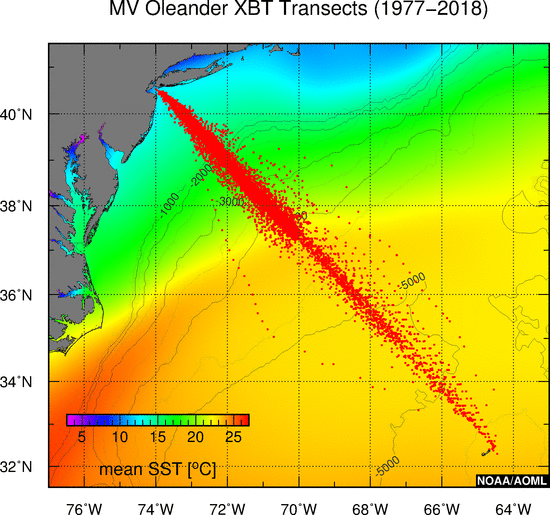The Oleander Project is a collaborative effort between the
University of Rhode Island (URI),
Stony Brook State University of New York (SUNY),
the NOAA Northeast Fisheries Science Center (NOAA/NFSC), and the NOAA Atlantic Oceanographic Meteorological Laboratory (NOAA/AOML) to collect oceanographic data such as ocean currents, upper ocean temperature, sea surface salinity, and surface carbon dioxide (CO2) in the highly dynamic region between New Jersey and Bermuda through the aid of the Ship Of Opportunity Program (SOOP).
The Bermuda Container Line (BCL), owners of the MV Oleander,
provides the vital role of supporting the inter-institutional collaboration by agreeing to equip their container vessel with oceanographic instrumentation and to collect the aforementioned data, at no extra charge, as the MV Oleander crosses the route from the continental shelf near New Jersey, to the Slope Sea, the Gulf Stream, and part of the Sargasso Sea near Bermuda. Both URI and SUNY measure ocean currents by utilizing a shipboard Acoustic Doppler Current Profiler (ADCP) (since 1992). NFSC collects zooplankton and phytoplankton by conducting transect surveys
with their Hardy Continuous Plankton Recorder (since 1971). NFSC, along with AOML, also provides support for the collection of upper ocean temperature and surface salinity. NFSC deploys XBTs and conducts surface salinity measurements (since 1977). AOML, on the other hand, equips the MV Oleander with XBTs and a flow-through thermosalinograph (TSG), and provides expertise in software, data quality control, and data distribution. Lastly, AOML also measures the exchange of CO2 across the air-sea interface and its eventual penetration into the ocean (pCO2).
